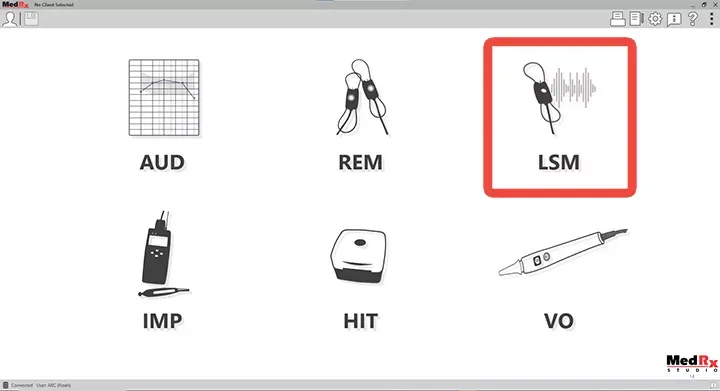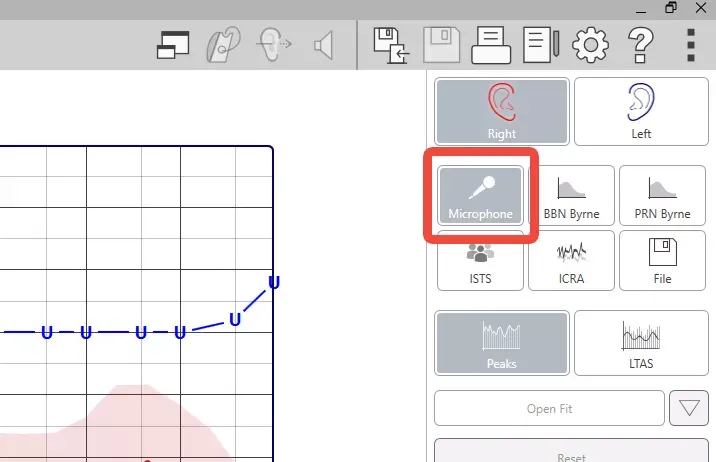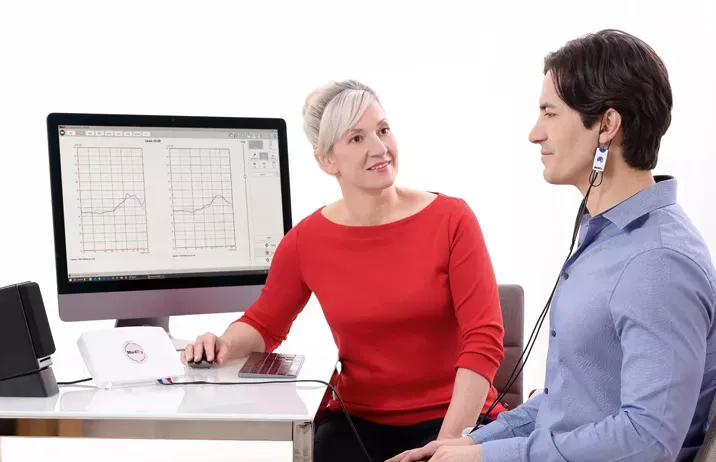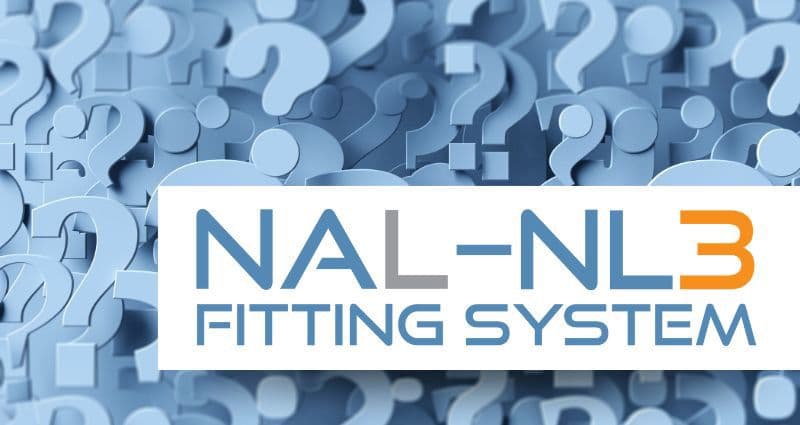Standard LSM Tests
While different manufacturers’ LSM software will vary, such as including other test stimuli, you can expect any comparable brand to allow you to do these standard Live Speech Mapping tests. You can find the following tests in MedRx Studio’s LSM module under the LSM tab.

The Initial Fitting
After you have determined a patient’s hearing loss level and find they’re a candidate for hearing aids, you will want to schedule an appointment for their hearing aid fitting. At the initial fitting, you will counsel the patient on what to expect from the probe mic and provide instructions for the remainder of the test.
When conducting Live Speech Mapping on a patient for the first time, you will start by using ISTS (International Speech Test Signal) or recorded speech such as the Rainbow Passage. You will likely always test at 65dB, the standard level for conversational speech, although ideally, you should also test at levels 50 and 80 to be thorough in your assessment.
Some audiologists may choose to test for MPO (maximum power output) for the hearing aid. Establishing the MPO for the hearing aids in the initial fitting ensures that the hearing aid does not exceed the patient’s UCL (uncomfortable loudness level).
In MedRx Studio, this is not a test that comes standard on the LSM screen; however, you can customize your view to include the MPO test if you wish.
After you have adjusted the hearing aids to the levels on your targets, you can send the patient home to test their new hearing aids.
How to enable the MPO test tab in Studio software
The Follow-Up Appointment
Once the patient has had time to test their hearing aids, you will want them to return for a follow-up appointment to ensure the instruments are at the correct levels. In this appointment, the patient can also present any concerns or complaints.
At this point, it is more common to test at the 50 and 80 dB levels in addition to the standard 65 dB. Testing in the extended range allows you to troubleshoot potential issues. You will conduct this exactly as you did the 65dB test, but repeat until you have adjusted your peaks accordingly.
Sometimes a patient will complain that speech and sound are too soft or loud, in which case you could test at additional levels
Addressing Concerns
Many patient concerns are addressed by adjusting at multiple levels and testing for soft and loud instances. However, there are a few situations that will require additional tests.
Occlusion Effect
Sometimes, patients with custom in-the-ear hearing aids or molds will complain that their voice sounds wrong. Or, it sounds like they’re “speaking in a barrel” or “feel blocked up.” This experience can indicate occlusion—a build-up of self-generated, low-frequency energy in the ear canal.
However, it’s important to note that a complaint about their voice does not automatically mean there is occlusion. The OE test in Studio will objectively determine whether there is occlusion or not.
In MedRx Studio software, you can find the testing screen for occlusion on the OE tab for “Occlusion Effect.” In this test, the hearing aids are off, and the clinician will ask the patient to make an “E” sound with the aids out and then repeat with the aids in. A large peak in the low frequencies demonstrates occlusion, an issue that can be fixed by physically modifying the hearing aid. If not, it is most likely a setting within the hearing aid you can adjust.
Situational Concerns
Each patient is a bit different. While many will come in with similar complaints or stories of it getting harder to hear, others may have specific hearing concerns related to their lifestyle or daily activities.
Sound files help HCPs test different potential scenarios where the patient may have difficulty hearing. Unlike ISTS, these stimuli will test for different situations or activities, such as hearing children’s voices, speech in a quiet or noisy environment, a busy restaurant, or music.
For example, the Rainbow passage we mentioned for the standard tests also comes with a non-standard children’s voice option you can play if the patient complains specifically about children’s or high-pitched voices. These recordings are also a great counseling tool as many patients may have grandchildren who are more difficult to hear as their hearing worsens.
Sound files are a great tool to ensure you have the best fit possible for your patient’s hearing aids, but they also serve as a valuable counseling tool and can make patients more comfortable with their hearing instruments.
Another extremely valuable test you have in your wheelhouse is the ability to use the patient’s family member or friend’s voice for the test. To do this, select the microphone button on the LSM tab and use the patient’s loved one as a live stimulus. Their voice helps tie in real use-case scenarios and demonstrate the hearing aid’s performance in a realistic day-to-day scenario.
The microphone test is actually where the terminology “Live Speech Mapping” comes from. The patient’s friend or family provides a “live speech” stimulus for the hearing aid verification fitting.

Advanced LSM Equipment, Designed for You
MedRx’s computer-based solutions offer advanced equipment at your fingertips. MedRx offers several different product solutions for Live Speech Mapping, all designed with intentionality and simplicity at the forefront.
AWRC and ARC
The AWRC is MedRx’s newest addition to the product line and features new Bluetooth wireless probe microphones for more efficient testing. In addition to its LSM capabilities, the AWRC doubles as an audiometer.
The ARWC’s space-saving 2-in-1 testing technology allows you to consolidate equipment and streamline office operations. Advanced practitioners may find this design extremely convenient, as the probe mics holder can be mounted on a wall or tucked away from sight.
Similar to the AWRC, the ARC is a combo audiometer and Speech Mapping system but is a more affordable option for clinicians willing to forgo the wireless probe mic set-up.
Both options also include REM testing software.

MedRx AWRC System

AVANT ARC System
REM Speech+
The REM Speech+ is MedRx’s tried and true standard Real Ear Measurement and Live Speech Mapping verification system. The REM Speech+ combines the familiarity of traditional REM testing and modern Live Speech Mapping through computer-based binaural verification.
The REM Speech+ is preferable if you’re looking to upgrade to new equipment for Live Speech Mapping but are already set and happy with your audiometer.

AVANT REM Speech+ System
Verification Software
All MedRx computer-based verification equipment operates with MedRx Studio software, and includes traditional REM and modern LSM modules. Our newest feature—the new probe tube depth guide is a handy tool for judging the distance you are from the eardrum when placing the probe tube. While beginning HCPs can use this tool as a guide for themselves, experienced providers may find more value in the Depth Guide as a counseling tool for nervous or jumpy patients.
Experts in Speech Mapping
MedRx Diagnostics are experts in Live Speech Mapping and can help you make strides in your fittings. Upgrade your equipment to receive a free Beginners and Advanced training session with one of our experienced training professionals.
Not only will they ensure you understand and can use your MedRx equipment, but they will help you tailor your setup to your clinic’s unique testing and fitting scenarios. From initial setup to support years down the road, we’re here to help you provide the best care to your patients every single day.
Still testing new solutions? Schedule a free online demo with one of our representatives and see our computer-based audiometry and fitting systems in action. Ask questions, see tests conducted using your hearing aid software, and get a feel for the product interface with zero commitment.



